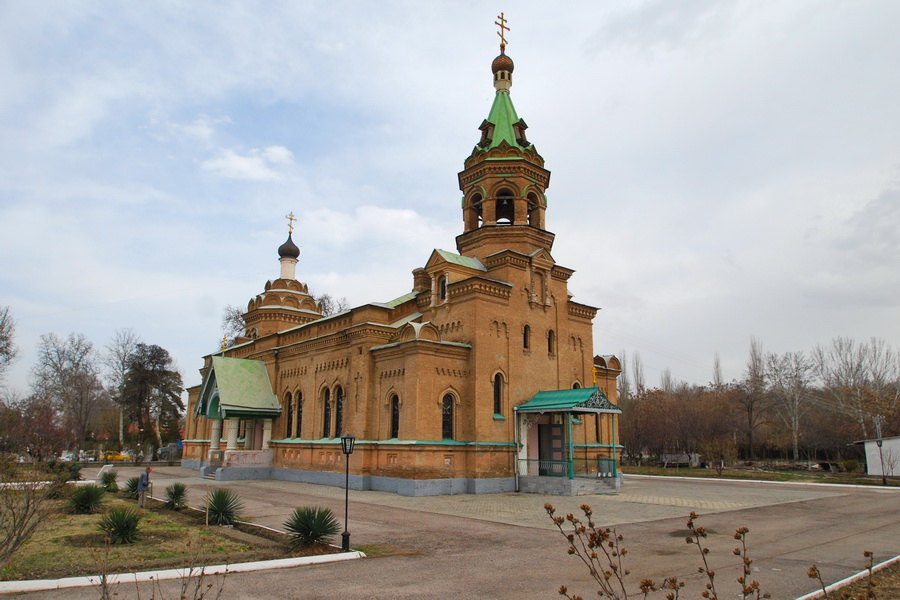European part of Samarkand

Russian Samarkand is a collective term for the buildings constructed after the city's conquest by the Russian Empire in 1868. It encompasses a broad area shaped by a fan-like arrangement of neighborhoods extending along three newly built streets. This became the European part of the city, with nearly 500 administrative and residential buildings. Churches, schools, hospitals, theatres, and libraries were established here, along with the layout of park alleys and sidewalks.
History
Construction of the European part of Samarkand began under the city's first Russian governor, Alexander Konstantinovich Abramov. University Boulevard, designed to separate the old and new (Russian) parts of the city, was once named Abramovsky in his honor.
In 1888, Samarkand was connected to the Trans-Caspian Railway, and a railway station was built. To this day, the railway remains vital for both domestic and international train travel.
The new part of the city quickly saw the emergence of post offices, telegraph offices, banks, hotels, shops, and other socially significant institutions.
Main Buildings
Church of St. George the Victorious (inactive) – This is the oldest Orthodox church in Samarkand, constructed in the 1880s near the central square where public festivals, official events, and military parades took place. The church was closed in 1924 and repurposed as a club for the Society for the Promotion of Defense, Aviation, and Chemical Construction. Its bell tower was demolished and replaced with an airplane. Despite extensive alterations, the building still retains its distinctive entrance and graceful arched gallery.
Cathedral of St. Alexius of Moscow – The second Orthodox cathedral in Uzbekistan (after the Cathedral of the Dormition in Tashkent), this church is a key religious and cultural site for Orthodox Christians in Samarkand and beyond. Built in the early XX century for the Russian military garrison, it was closed during the Soviet era and returned to parishioners only in 1996. The spacious interior, free of supporting columns, provides excellent acoustics. Today, regular services are held here.
Church of the Intercession of the Holy Virgin – Another pre-revolutionary Orthodox church that has survived, it was built of brick in 1903 and features a small bell tower. The church was known for its parish school, founded by a childless couple who also established the church.
Women's Gymnasium – an important educational institution of the late XIX and early XX centuries, the gymnasium played a key role in advancing women's education in Central Asia. It offered not only literacy and numeracy but also practical skills. Architecturally, it combines European design with decorative elements of Russian classicism. Today, the building houses the biology department of Samarkand State University.
Russian-Chinese Bank building – constructed in 1896, this striking example of classical architecture features clean lines, harmonious proportions, and decorative facades. It served as a major financial institution, symbolizing the integration of local culture with emerging Western influences. The building remains one of Samarkand’s most attractive historic structures.
Military Governor’s Residence – constructed in 1875, this mansion housed the governor’s private quarters and offices. It originally served as the city’s administrative center and later became the seat of the city executive committee during Soviet times. It now serves as the Samarkand City Hall.
Children’s Library – this building was a gift from the Russian administration and also housed the city’s first reading room. By the early XX century, the need for a library had grown significantly due to the expanding Russian-speaking intelligentsia. The library still functions today.
Wine Museum at the Khovrenko Winery housed in the former residence of Russian merchant Dmitry Filatov, who arrived in Samarkand in the mid-XIX century and began producing wine for Russian troops. The winery soon gained recognition as one of the best in the Russian Empire.
Of course, Samarkand is renowned for its world-famous landmarks such as Registan Square, the Gur-Emir Mausoleum, and the Shah-i-Zinda necropolis. Yet the historical and architectural legacy of the European part of the city is also well worth exploring.

